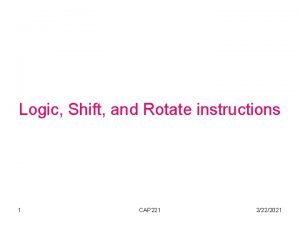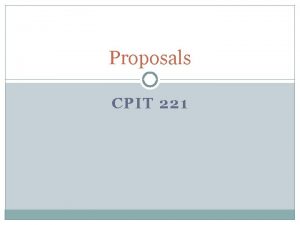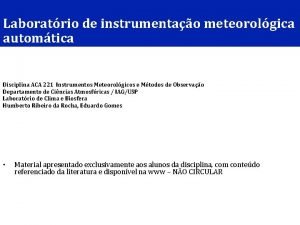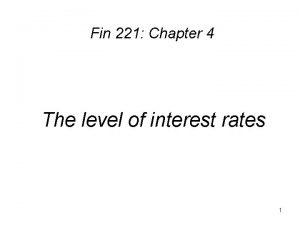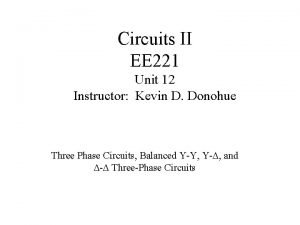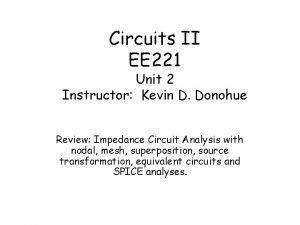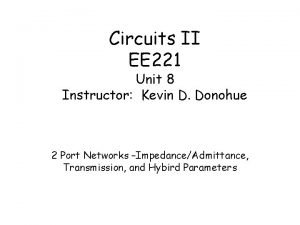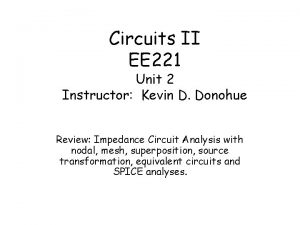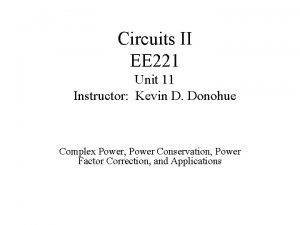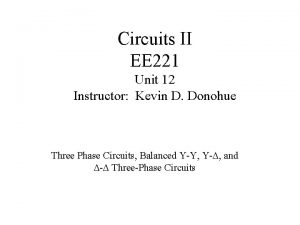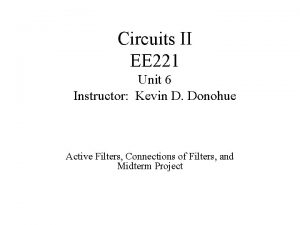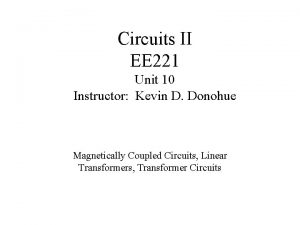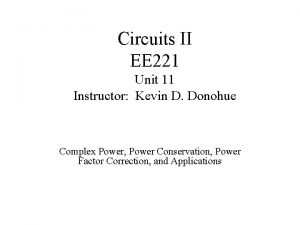Circuits II EE 221 Unit 7 Instructor Kevin















- Slides: 15

Circuits II EE 221 Unit 7 Instructor: Kevin D. Donohue Active Filters, Connections of Filters, and Midterm Project

Useful Circuits: Describe the transfer functions of these circuits: Non-Inverting Op Amp: gain = (1 + Rf / R 1) Voltage Follower: gain = 1 Inverting Op Amp: gain = (- Rf / R 1)

Cascading Filter Stages: no Loading Effects: Given two active filter circuits with transfer functions and , their series combination has a transfer function equal to the product of the individual transfer functions: provided that the connection between these circuits does not significantly alter the output resistance of the first circuit or the input resistance of the second circuit (i. e. no loading effects). V 1 o = V 2 i VTi = V 1 i V 2 o= VTo Homework (1): In Matlab create bode plots for a first-order high-pass filter (with G = 2 and fc = 1 k. Hz) in series with a second order bandreject filter (with f 0 = 5000 Hz, B = 500 Hz, and GDC = G = 1 ).

Other Useful Circuits The summing amp: The differential amp:

Adding Outputs of Filter Stages Given two active filter circuits with transfer functions and , the TF resulting from their parallel connection is the sum of the TF (the complex TF values, not simply the magnitudes), provided that the connection of these circuits does not significantly alter the output resistance of the first circuit or the input resistance of the second circuit (i. e. no loading effects). If the outputs are connected through a summing amp with gains 1 and 2 the combined TF become: VTi V 1 o VTo V 2 o

Adding Outputs of Filter Stages Homework (2): In Matlab create Bode plots for 2 second order bandpass filters (BPF 1 with Go = 10 d. B and fo = 9 k. Hz, B = 3 k. Hz, and BPF 2 with Go = 7 d. B and fo = 6 k. Hz, B = 800 Hz) connected in parallel through a summing amp with a gain of -0. 5 for the output of BPF 1 and a gain of -3. 5 for the output of BPF 2. For the magnitude plots, plot them in both d. B (typical Bode plot) and linear (without the 20 Log 10 scaling). Homework (3): Repeat Problem 2, with different gains for the summing amp. Change the summer gain for the BPF 1 node to -3 and the gain for the BPF 2 node to -0. 5. Compare he Bode plots with those in Homework Problem 2. Homework (4): Compute threshold of hearing curve for your ear at the frequency points indicated in the hearing-aid project and scale it as described in the project (and on the web page) and plot it against the normal threshold of ear. Describe the environment where you did the hearing test at (quiet office using speakers, … noisy lab with headphones …. )

Midterm Project Ø Ø Ø In this project you will design a hearing aid to correct your "client's" hearing to normal at the threshold of hearing. This project will combine your study of the AC circuit frequency response, transfer functions, passive and active filters, and filter combining to design a filters with a transfer function magnitude of a specified shape. The outcomes of this project involve the following components: Ø Ø Implementing a "Design Process" Using a top-down approach to solve complex designs Extending knowledge of filter design Developing plans for efficient/effective teamwork

General Design Process 1. 2. 3. 4. 5. 6. 7. Develop a set of specifications to formulate a clear and precise problem statement. Propose a set of potential solutions at the top-level. Decide on the most feasible or promising design. Develop solution(s) (build circuit protopypes or create computer simulations for testing). Optimize critical parameters of the design(s). Test design(s) against specifications. If design performance is not satisfactory, return to steps 2 through 6 (depending on the amount redesign necessary to achieve satisfactory performance). If design performance is satisfactory, complete documentation on the design process, technical description of critical components, and performance analysis.

General Design Process Ø Ø The proposal report involves completing steps 1 through 3 and creating a time table for accomplishing steps 4 through 7. The final documentation should be complete enough for someone else to clearly compare the designed circuit’s performance with the criterion in the problem statement, build your circuit, and verify performance results.

Top-Down Design Ø Ø Ø The top-down method develops a solution by initially proposing a design in terms of functional blocks. This first and most general block diagram is called the top level. Then each functional block in the top level is broken down into more detailed and specific functional blocks to create the second level. Once the functional blocks are detailed enough so that a circuit to perform the function is easily determined, the process is finished. Example: Build a hearing aid with the following specifications. . . The necessary functions (convert sound waves to electric signal, preamplify signal, filter signal, convert amplified and filtered signal back into sound waves). This suggests the following top-level Microphone Ø Ø Pre Amp Custom Filter Power Amp Speaker Specifications for the function and input-output characteristics must be developed for each block. Also note that “top” is a relative term. This is a top-level design if your assignment was the whole hearing aid.

Top-Down Design Ø At the second design level (relative to the hearing aid as first level) each of above functional blocks are broken down into finer detail. For example, assume the transfer function of the filter block is specified. The top-level design for the filter can be specified as (parallel approach - something in the specifications may suggest this combination): Band-Pass Filter 1 Band-Pass Filter 3 Band-Reject Filter 2 Band-Pass Filter 4 Summing Amp where Ø The purpose of band-pass filter 1 is to help shape the transfer function in the frequency range. . with a approximate gain of XX d. B, a resonant frequency near XX Hz, and approximate bandwidth of XX Hz … (Do this type of description for each block at this level).

Time Tables Ø Ø Once the top-level diagrams for your circuit have been completed, work can be assigned to determine the actual circuits, connect them, optimize performance, test against specifications, redesign, document, and complete the final report. The most efficient way to assign the work is to have as many parallel tasks going on as possible. If someone is doing nothing until some else finishes his or her task, the work should be redistributed. Rather than have someone in the group remain inactive for an extended time, you can at least assign several people to the same task, or work independently on the same thing and take the best result. Regular group meetings should be scheduled to keep tabs on the progress, to educate each other on findings, and make adjustments if necessary (almost always necessary). You should schedule to complete and test the design about a week before the due date, so the last week can be devoted to minor modifications (if needed) and completing the final report.

Engineering Notebooks It is important to develop organized work habits. As tasks become more complex, it is more difficult to remember results determined along the way. Write down all details, even documenting a bad approach helps organize your thinking and improve. This is also a critical record for establishing patents and getting various types of approval. The notebook should: Ø Verify what you have accomplished and when Ø Summarize the important results for future reference Ø Record work useful for debugging and completing final documentation The notebook should be a regular bound book. Each time you work on the project individually or as a group, you should enter the date into the notebook, what you did and the results. Thus, all work that you do regarding the project should appear in the notebook in chronological order. If errors are made, don't tear out the page. Just put a line through it and correct it in a later entry. Loose pages can be attached to pages in your notebook, if work was done on different paper or printed out from a computer.

Specifications and Problem Statement: Ø Ø Ø Unlike homework and test problems, design problems are typically under-specified. This implies there can be many solutions. It becomes difficult to judge a design in terms of right and wrong, but instead the judgment is in more vague terms such as bad, good, and better (best is often difficult to prove even for simple problems). The given specifications should be organized at the beginning of the project and stated in such a way that they can be measured when the final design is tested. Sometimes the specifications are given in terms of errors that should be minimized (or goodness maximized) or bounds on the error that should be satisfied. The problem statement should be as short as possible, while clearly stating all the specified criteria, along with some additional criteria, if necessary, to limit possibilities or create a useful way of computing the error.

Order of Events Ø Ø October 13 – Project assigned. Groups formed, notebook entries started October 13 - October 27 Ø Ø Ø Meet as a team, identify tasks and time-table Identify the design criteria Come up with your preliminary top-level design for your client Complete your preliminary report Project Proposal is due October 27 – November 22 Ø Ø Ø Ø Validate your top level design Optimize your transfer function with Matlab. Finalize your analyses and validate design approach with an error analysis based on ideal transfer functions of proposed filters Implement SPICE model for your optimized top-level design Realize design, use off-the-shelf components. Present final error and discuss how well design meets specifications. Final Report due & Engineering notebooks due November 22




